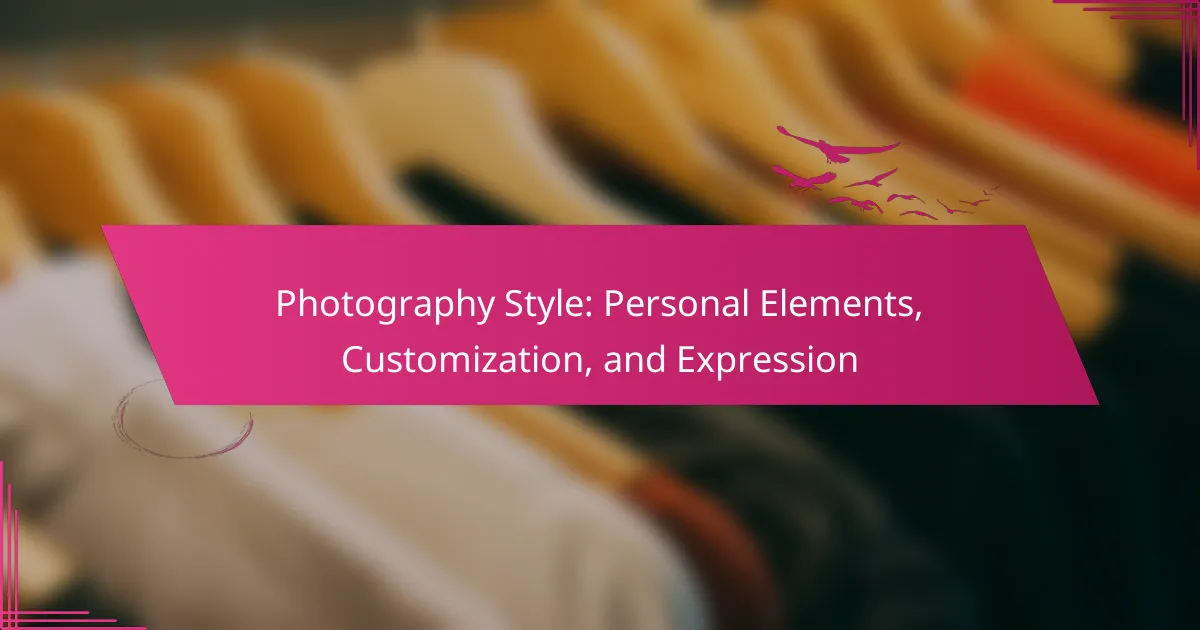Photography is a powerful medium for personal expression, allowing individuals to infuse their unique stories and experiences into their images. By customizing elements such as editing styles, props, and camera settings, photographers can create a distinctive style that resonates with their vision. This blend of personal elements and creative choices not only enhances the authenticity of the work but also deepens the emotional connection with viewers.

How can personal elements enhance photography style?
Personal elements can significantly enhance photography style by adding depth and individuality to images. By incorporating unique stories, colors, themes, and personal touches, photographers can create a more authentic representation of their vision and experiences.
Incorporating personal stories
Personal stories can transform a photograph from a simple image into a narrative that resonates with viewers. Consider the emotions and experiences tied to specific moments in your life; these can serve as powerful backdrops for your photography. For example, capturing a family gathering can evoke feelings of nostalgia and connection.
To effectively incorporate personal stories, think about the message you want to convey. Use your images to tell a story that reflects your journey, whether it’s through portraits, landscapes, or candid shots. This approach not only enhances your style but also engages your audience on a deeper level.
Using favorite colors and themes
Your favorite colors and themes can play a crucial role in defining your photography style. By consistently using specific color palettes, you create a recognizable aesthetic that can set your work apart. For instance, if you love warm tones, consider incorporating golden hues in your images to evoke a sense of comfort and warmth.
When selecting themes, think about what resonates with you personally. Whether it’s nature, urban landscapes, or abstract concepts, sticking to themes that reflect your interests can lead to more cohesive and impactful photography. Experiment with different combinations to find what best represents your style.
Reflecting personality through poses
Poses can reveal a lot about personality and can significantly influence the mood of your photographs. When directing subjects, encourage them to express themselves naturally, which can lead to more authentic and engaging images. For example, a relaxed pose can convey comfort, while a dynamic pose might express energy and excitement.
Consider the context of the shoot and how it aligns with your personality or the subject’s. A playful pose may work well in a fun setting, while a more serious pose might be appropriate for formal portraits. Tailoring poses to reflect individual personalities enhances the storytelling aspect of your photography.
Choosing meaningful locations
Locations can greatly influence the emotional impact of your photographs. Selecting places that hold personal significance can add layers of meaning to your images. For instance, shooting in a childhood neighborhood or a favorite vacation spot can evoke strong feelings and memories, enriching the viewer’s experience.
When choosing locations, consider accessibility and how well they align with your intended message. A serene beach might be perfect for a calm portrait, while a bustling city street could be ideal for capturing energy. Always scout locations beforehand to ensure they meet your vision and logistical needs.
Integrating personal objects
Incorporating personal objects into your photography can enhance the narrative and add a unique touch. Items like heirlooms, favorite books, or even clothing can serve as symbols of your identity and experiences. For example, including a beloved guitar in a portrait can tell a story about your passion for music.
When using personal objects, think about how they complement the overall composition. Ensure they don’t distract from the main subject but instead enhance the visual story. This integration can create a more intimate connection between the viewer and the photograph, making it more memorable.
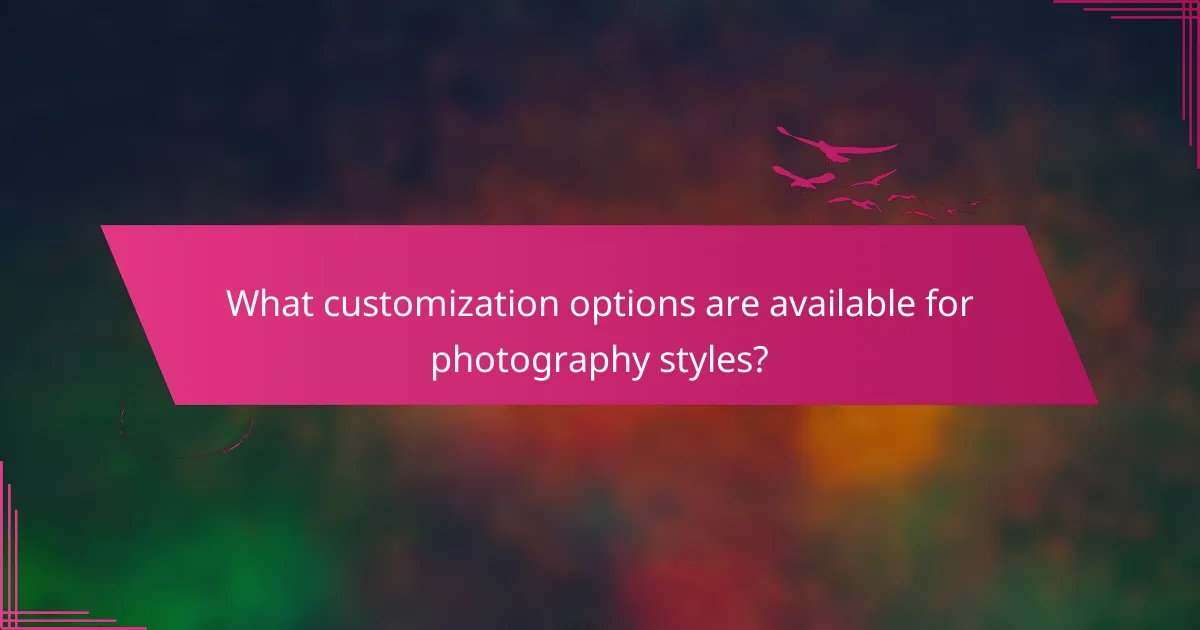
What customization options are available for photography styles?
Photography styles can be customized through various options that enhance personal expression and creativity. Key areas of customization include editing styles and filters, camera settings adjustments, props and backdrops selection, and post-processing techniques.
Editing styles and filters
Editing styles and filters significantly influence the mood and aesthetic of photographs. Popular editing styles include vintage, black and white, and high contrast, each offering a distinct feel. Filters can be applied during or after shooting, with options ranging from subtle enhancements to dramatic effects.
When choosing filters, consider the subject and setting. For example, a warm filter may enhance a sunset scene, while a cooler tone might suit a winter landscape. Experimenting with different styles can help you find a signature look that reflects your personal vision.
Camera settings adjustments
Adjusting camera settings is crucial for achieving the desired photographic style. Key settings include aperture, shutter speed, and ISO, which together control exposure and depth of field. For instance, a wide aperture (low f-stop number) creates a shallow depth of field, ideal for portraits.
Understanding the relationship between these settings allows for creative control. In bright conditions, you may need a faster shutter speed to avoid overexposure, while in low light, increasing the ISO can help capture details without a flash. Always test different settings to see what best suits your style.
Props and backdrops selection
Choosing the right props and backdrops can elevate your photography by adding context and interest. Props can range from simple items like flowers or books to more elaborate setups like furniture or themed decorations. Backdrops can be natural settings or studio-created environments.
When selecting props and backdrops, consider how they complement your subject. A rustic backdrop may enhance a vintage theme, while a minimalist setting can emphasize modern aesthetics. Always ensure that the props do not distract from the main subject but rather enhance the overall composition.
Post-processing techniques
Post-processing techniques are essential for refining images and achieving a polished look. Common techniques include cropping, color correction, and retouching. These adjustments can help correct imperfections and enhance visual appeal.
Utilizing software like Adobe Lightroom or Photoshop allows for detailed editing. For example, color grading can transform the mood of an image, while sharpening can enhance details. Be mindful not to over-edit, as this can lead to unnatural results. A balanced approach will maintain the authenticity of your work.
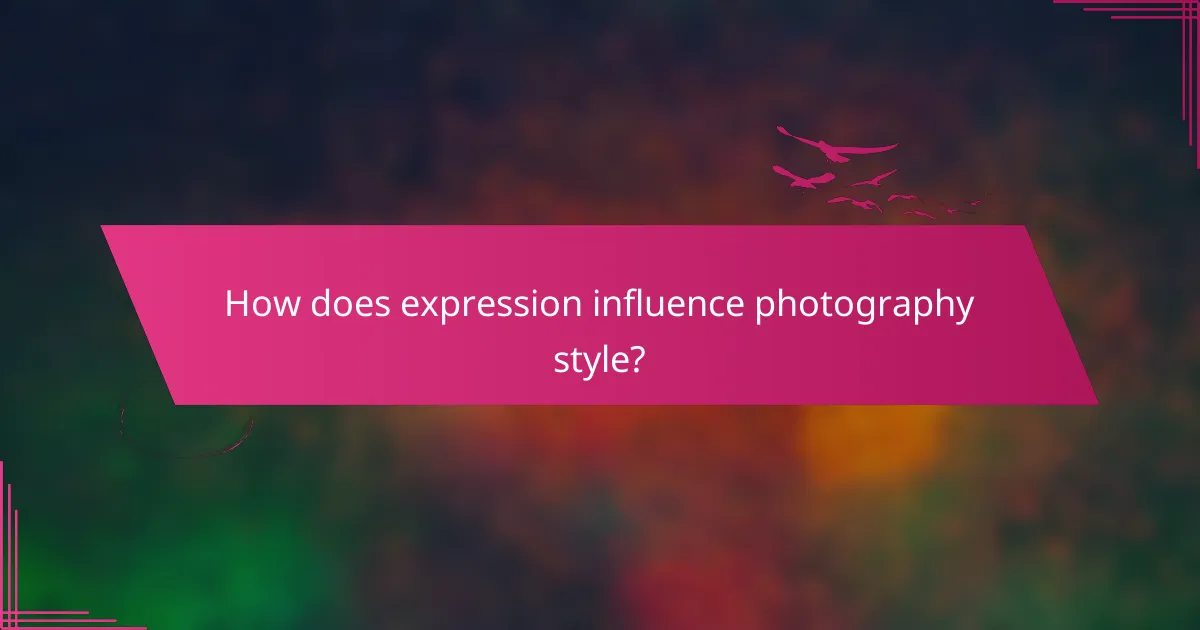
How does expression influence photography style?
Expression plays a crucial role in shaping photography style by conveying emotions and personal narratives. It allows photographers to create images that resonate with viewers, making the subject matter more impactful and relatable.
Capturing emotions and moods
To effectively capture emotions and moods, photographers should focus on the subject’s facial expressions and the overall atmosphere of the scene. Utilizing natural light can enhance feelings, as soft lighting often evokes calmness, while harsh shadows may suggest tension or drama.
Consider the context of the shoot; for instance, a joyful family gathering can be portrayed with bright colors and candid moments, while a somber event may benefit from muted tones and thoughtful compositions. Experimenting with different angles and perspectives can also help convey the desired emotional tone.
Using body language and gestures
Body language and gestures are powerful tools in photography that can communicate messages without words. A subject’s posture, hand movements, and even the direction they are facing can significantly influence the viewer’s interpretation of the image.
For example, an open posture can suggest confidence and approachability, while crossed arms might indicate defensiveness or discomfort. Pay attention to how subjects interact with their environment and each other, as these dynamics can add depth and context to your photographs.
Creating dynamic compositions
Dynamic compositions can enhance the expression in photography by guiding the viewer’s eye and creating a sense of movement. Techniques such as the rule of thirds, leading lines, and framing can help structure your images in a way that feels engaging and lively.
Incorporating elements like foreground interest or negative space can also contribute to a more compelling composition. Always consider how the arrangement of subjects and objects within the frame can amplify the emotional message you wish to convey.
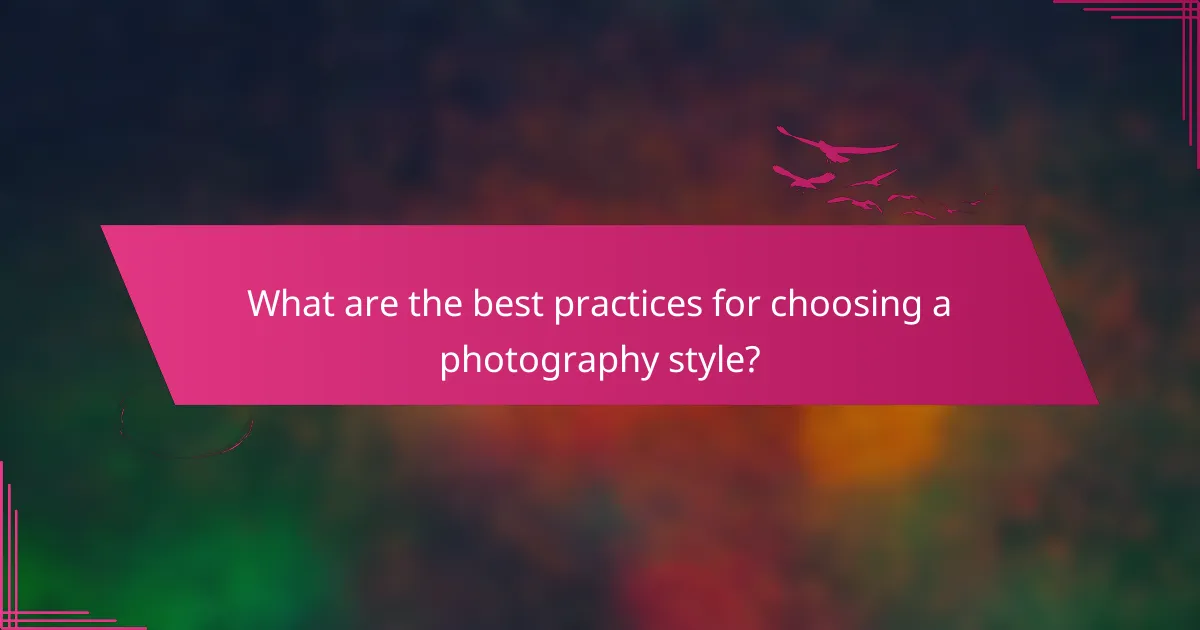
What are the best practices for choosing a photography style?
Choosing a photography style involves understanding your personal preferences, exploring popular trends, and experimenting with various techniques. By following these best practices, you can develop a unique style that reflects your artistic vision and resonates with your audience.
Identifying personal preferences
Start by assessing what you enjoy most in photography. Consider the subjects that captivate you, whether it’s landscapes, portraits, or street photography. Reflect on the emotions you want to evoke and the stories you wish to tell through your images.
Creating a mood board can help clarify your preferences. Gather images that inspire you, noting the colors, compositions, and styles that stand out. This visual reference will guide your choices as you develop your photography style.
Researching popular styles
Explore various photography styles to understand what resonates with you. Popular styles include documentary, fine art, minimalism, and commercial photography. Each style has its own techniques and aesthetics, so familiarize yourself with their characteristics.
Follow photographers whose work you admire on social media or photography platforms. Analyze their styles and techniques, considering what elements you might want to incorporate into your own work. This research can spark ideas and help refine your artistic direction.
Experimenting with different techniques
Once you have a sense of your preferences and popular styles, start experimenting with different techniques. Try varying your camera settings, using different lenses, or exploring new editing methods. This hands-on approach will help you discover what works best for you.
Don’t hesitate to step outside your comfort zone. Attend workshops or join photography groups to learn from others and gain new perspectives. Document your experiments and reflect on what you enjoy most, allowing your style to evolve naturally over time.
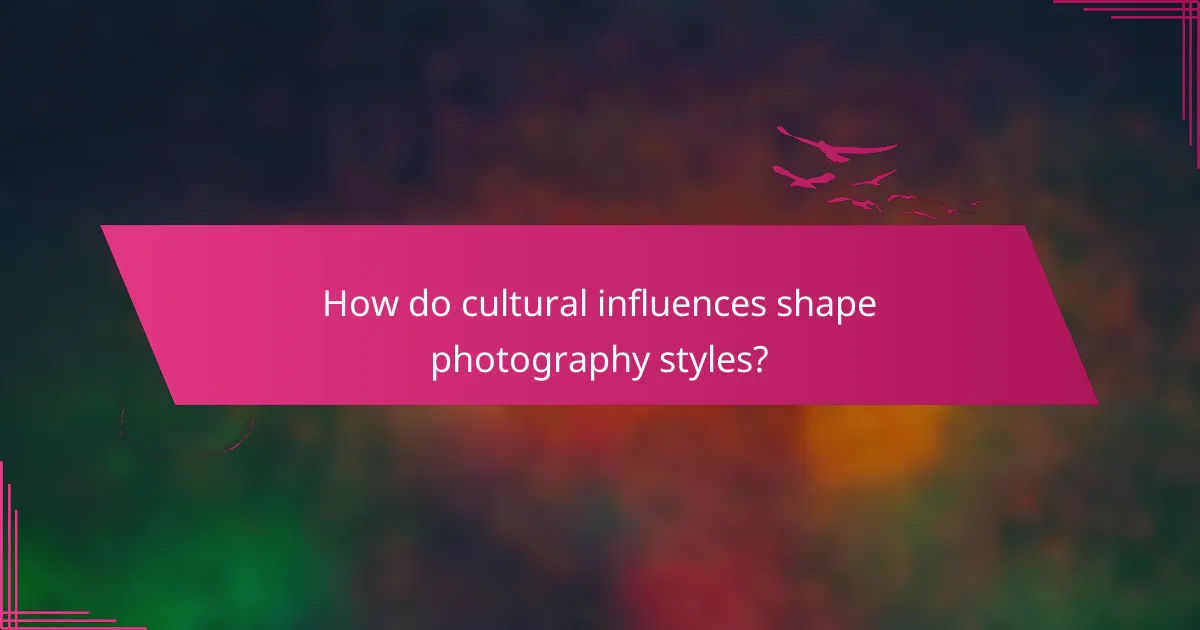
How do cultural influences shape photography styles?
Cultural influences significantly shape photography styles by dictating aesthetic preferences, subject matter, and techniques. Photographers often draw inspiration from their cultural backgrounds, leading to unique visual narratives that reflect local traditions and values.
Regional aesthetics and traditions
Regional aesthetics and traditions play a crucial role in defining photography styles. For instance, in countries like Japan, minimalism and nature are prevalent themes, reflecting the cultural appreciation for simplicity and harmony. In contrast, vibrant colors and dynamic compositions may dominate in regions like Latin America, where festivals and community life are central to cultural expression.
Understanding these regional aesthetics can help photographers tailor their work to resonate with local audiences. Incorporating traditional elements, such as clothing or architecture, can enhance the authenticity of the photographs.
Influence of local art movements
Local art movements significantly impact photography styles by introducing new techniques and philosophies. For example, the influence of Impressionism in France led to a focus on light and color in photography, encouraging photographers to capture fleeting moments. Similarly, the rise of modernism in the 20th century emphasized abstraction and experimentation, shaping contemporary photography practices.
Photographers should study these movements to understand their historical context and apply relevant techniques to their work. Engaging with local art communities can also provide valuable insights and inspiration.
Impact of cultural narratives
Cultural narratives inform the themes and subjects that photographers choose to explore. These narratives can encompass historical events, social issues, or community stories that resonate with a specific audience. For example, documentary photographers often focus on cultural narratives to highlight social injustices or celebrate local heritage.
By tapping into these narratives, photographers can create powerful images that evoke emotions and provoke thought. It is essential to approach these subjects with sensitivity and respect, ensuring that the stories told are authentic and representative of the communities depicted.
